Great Garden Walls
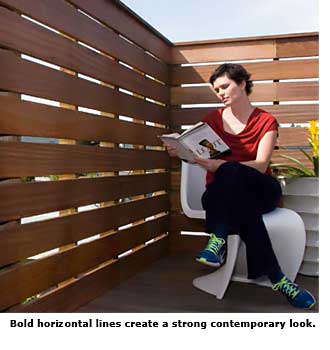
Fences are the walls of the garden room. They quite literally extend the structure and form of your modern home into the landscape, creating spaces for enjoying the out of doors.
But what makes up the composition and dimensions of a well-designed modern fence—and how should fencing relate to the interior of the home?
"If all rooms indoors and out were the same size and shape," cautions master California landscape designer Garret Eckbo in his 1956 book 'The Art of Home Landscaping,' "our world would be a prison, and we would go mad. We all enjoy the contrast of open space with complete enclosure."
The most successful fencing in the modern garden takes its cue from the clean lines and rigorous geometries of house, building on the important relationship of indoor and outdoor space and expanding it all the way to the property line.
"The fence design needs to be compatible with the exterior façade of the home, and the transition from the building to the fence should be intentional and seamless," says David Thimgan, whose Thimgan Architectural Group has renovated dozens of Sacramento Streng and Eichler homes. "This can be achieved by using the same materials as the façade of the house, or with compatible materials that contrast. Carrying trim lines or other façade details form the house to the fencing can help achieve this blend from the home to the fencing."
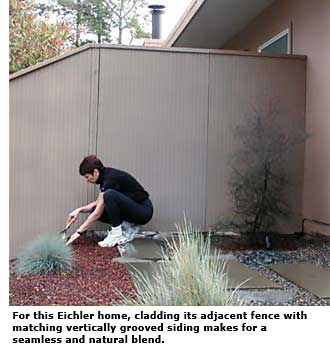
Rustic stone, rough irregular textures, or ornately carved and ornamented wood structures are often at odds with the basic minimalist vibe of modern and contemporary buildings and are likely not the best choices for defining the boundaries of the gardens that enclose them. This does not mean that contrast is not a good idea, explains Thimgan, who sometimes utilizes contrasting materials to punch up the visual impact of his fence designs.
"Heavy and light materials are intriguing," he says. "There are a number of light open-weave metal screens currently being applied in commercial architecture that hold promise for residential fencing. In contrast to that, you have heavy and substantial materials such as cut stone and concrete. If done well, either of these will contrast nicely with the clean lines and smooth surfaces of a modern home."
Vertical textures that echo the patterns of siding or long horizontal planes that carry the line of a building wall outward are both appropriate design strategies for the modern landscape. Many of the original gardens created by prominent mid-century designers included fencing that had strong vertical character.
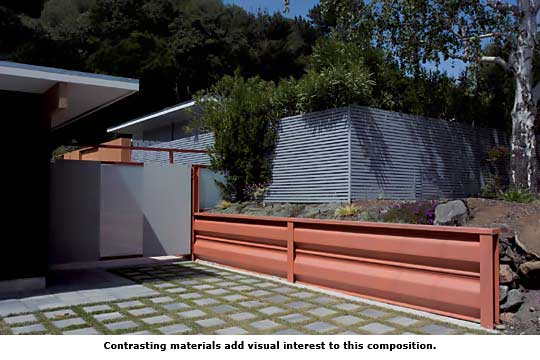
Architect Lourdes Garcia of Garcia DeCredico Studio, based in the East Bay, has worked with many Eichler homeowners and believes that the vertical siding that is unique to those homes is another great material for fence-making.
"This type of surface texture offers a nice opportunity for the play of shadows throughout the day," Garcia says. "By cladding both sides of the fence with siding that is read as walls, the technique very effectively expands the visual presence of the home. Other texture materials, such as bamboo, also offer this possibility."
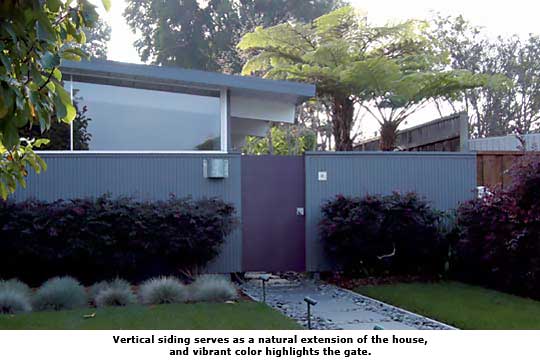
Of course, horizontal patterns can also be found in photographs from the period, but fencing with a strong horizontal look is in many ways a more contemporary design approach. Either strategy works well, but if the goal is a garden with a 'retro' feel, a fence that includes a vertical pattern may be the more appropriate choice.
The amount of security desired is also a consideration when making the vertical versus horizontal choice. Obviously, fences that include horizontal members are easier to climb, so care should be taken with the design to minimize the use of the fence as a potential ladder.
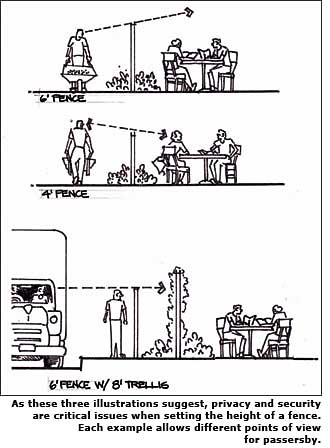
Most municipalities have design standards that set the maximum height, and sometimes the materials that can be used in residential fencing. As a result, the six-foot-high-board property line fence is nearly universal design response from most builders and homeowners.




